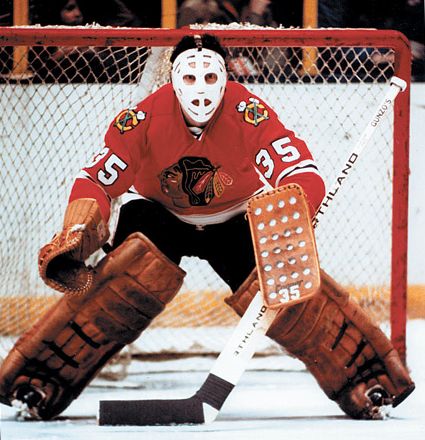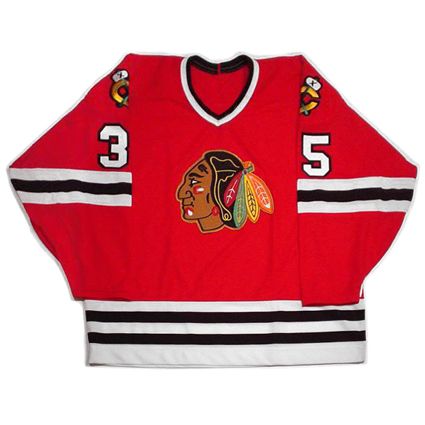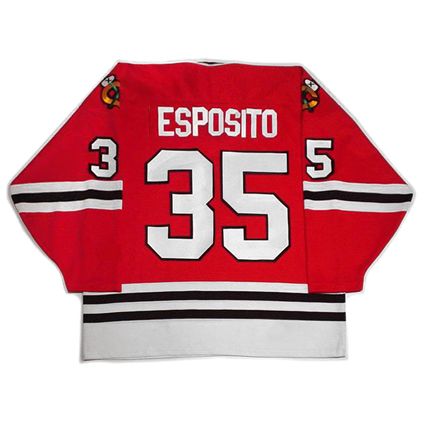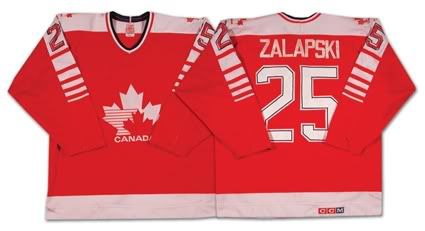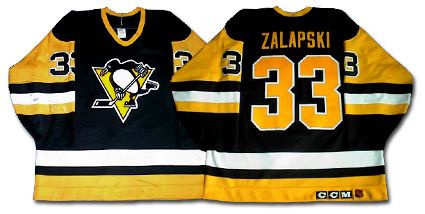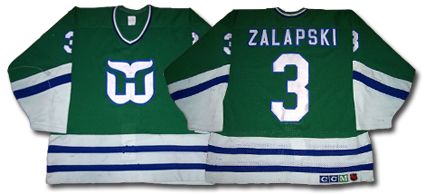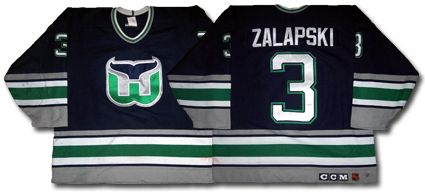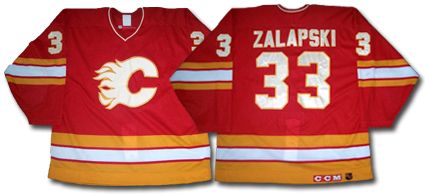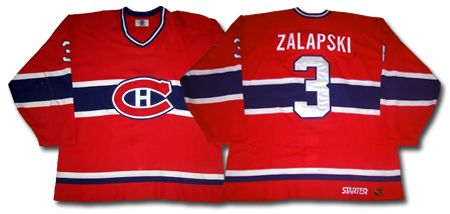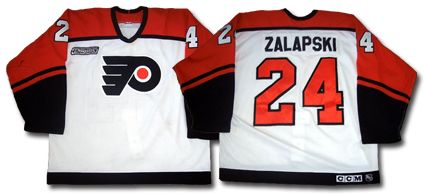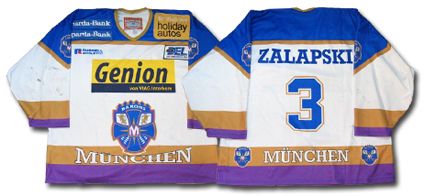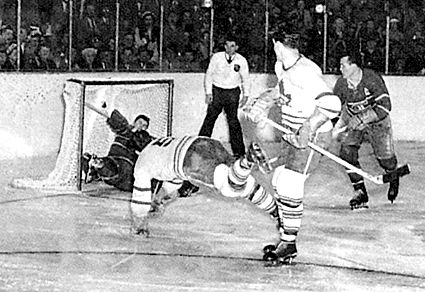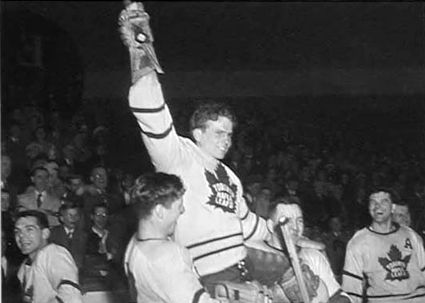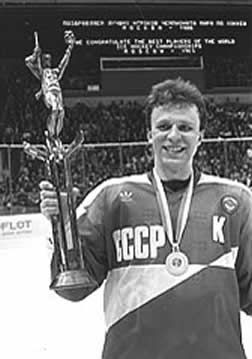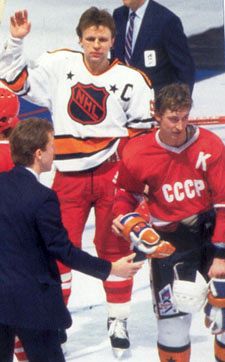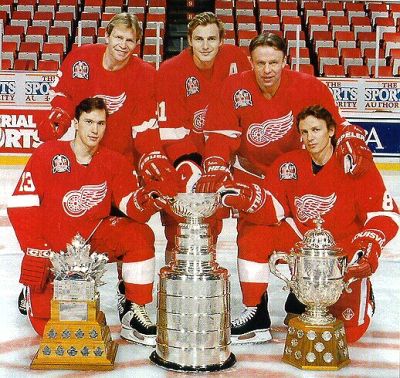Saturday, April 24, 2010
1988-89 Los Angeles Kings Wayne Gretzky Jersey
On this date in 1989, the Los Angeles Kings Wayne Gretzky scored his 86th career playoff goal, making him the leading goal scorer in playoff history, passing Mike Bossy's 85, in a 5-3 loss to the Calgary Flames.
Gretzky's first NHL season came in 1979-80 following his Edmonton Oilers being absorbed by the NHL. He would score 2 goals in 3 games to begin his assault on the record. The following season saw the Oilers advance to the second round for the first time and gain 9 games of playoff experience in which Gretzky would add 7 goals. A quick exit the following season limited Gretzky to just 5 playoff games in which he would score 5 goals.
The 1983 playoffs would begin a remarkable period in Stanley Cup playoff history, as the Oilers would advance to the finals for the first time, playing 16 games along the way. It was the first of seven consecutive seasons in which the Gretzky would play a minimum of 10 post-season games, and often upwards of 16 with a high of 21 in 1987, giving Gretzky 114 games in seven seasons to add to his playoff goal scoring totals during the height of the Oilers dynasty.
His goal totals would rise from 12 in 1983, to 13 during the Oilers first Stanley Cup championship in 1984 to his best ever with 17 as they repeated as cup champions and Gretzky was named the winner of the Conn Smythe Trophy in 1985. Those 17 goals in 1985 rank as the third highest in a single playoff year. For the remainder of the streak of double-digit playoff game seasons, he scored 8 in 1986, 5 in 1987 on the way to another Stanley Cup, 12 in 1988 for Gretzky's second Conn Smythe Trophy and fourth and final Stanley Cup.
Following that season, Gretzky was famously traded to the Los Angeles Kings, where the playoff run of double-digit games would continue. He would score 5 goals in 11 games to put his career total at 86, with the 5th goal coming on this date in 1989, which moved him into first place all time, surpassing the record of 85 held by Bossy since his retirement in 1987.
The Kings would make the playoffs for the next four seasons, allowing Gretzky to make the Stanley Cup playoffs for fourteen consecutive seasons. Hampered by injuries, Gretzky would only play in 7 of the Kings 10 playoff games in 1990, which limited him to just 3 goals.
He would score 4 more in 12 games in 1991 and a pair in 1992 as the Kings were bounced after 6 games in the first round.
1993 saw the Kings take a run at the maximum number of possible games, as they had a 6 game series in the first round, 6 in the second, the full 7 in the conference finals and five more in the cup finals, for a total of 24 games out of a maximum 28. Gretzky led Los Angeles with 15 goals that postseason, the second highest of his career, which allowed him to become the first player in NHL history to surpass 100 career playoff goals.
Unfortunately, the Kings would fail to qualify for the playoffs over the next two seasons, and with things looking bleak for the future, Gretzky was traded to the St. Louis Blues late in the 1995-96 season, allowing him another shot at the playoffs for the first time in three seasons. His role was mainly as a playmaker, as he produced assists at a rate of more than one per game, but was limited to only 2 goals in 13 contests.
He moved to the New York Rangers for 1996-97 season and scored the final 10 playoff goals of his career in 15 games as the Rangers made a run to the Eastern Conference Finals. Gretzky's career would wind down over the next two seasons as the Rangers would fail to qualify for the playoffs either season, leaving his career total at an NHL record 122 goals.
Today's featured jersey is a 1988-89 Los Angeles Kings Wayne Gretzky jersey. Gretzky, the long time captain of the Oilers wore the "A" as an assistant captain during his first season in Los Angeles in deference to the Kings incumbent captain Dave Taylor.
1988-89 was the first season for the Kings new uniform set, as they radically changed their entire look, abandoning the purple and gold colors of royalty, which they shared with the NBA's Los Angeles Lakers, to the trendy and very much in favor black with the addition of silver and white, which they would share with the Raiders of the NFL, who also played in Los Angeles from 1982 to 1994.
While the basic jersey worn by the Kings would remain unchanged from 1988 to 1998, the customization would go through a series of detail changes. The white jerseys started life with silver names and numbers outlined in black and the name on nameplates. The sleeve numbers were silver outlined in white.
In 1991, the names and numbers changed to three colors, silver trimmed in white and outlined in black for one season. The names were no longer on nameplates. Finally, in their fifth season of use, the numbers would change to a higher contrast and much more readable black, which were trimmed in white and outlined in silver. The names were simplified to one color black and this specification would remain in effect throughout the rest of the life of the jerseys.
The black jerseys would have a similar history, starting out with silver names and numbers outlined in white and silver sleeve numbers outlined in black and the names on a nameplate.
1991 saw the move to three colors in the combination of silver names and numbers trimmed in black and outlined in white. Sleeve numbers were now silver trimmed in white and outlined in black, while the nameplates were no longer in use.
Changes for 1992 saw the names simplified to one color white, while the sleeve numbers were changed to black, trimmed in white and outlined in black and would remain this way until this set was replaced in 1998-99.
Today's video section features Wayne Gretzky playoff highlights. First up is the 1993 season in which Gretzky scored 15 goals and led the Kings to the finals.
Next is the 1988 season in which Gretzky won the Conn Smythe and led the Oilers to their fourth Stanley Cup.
Dasherboard: The United States successfully defended the World U18 Championship in Minsk, Belarus with a 3-1 win over Sweden in the gold medal game. The United States went through the tournament with only one loss, that to Sweden 4-2 in the preliminary round, a loss avenged by winning the rematch for the gold medal.
Luke Moffat, Justin Falk and Rocco Grimaldi scored for the Americans, as the US led 3-0 heading into the third period.
Jack Campbell of the USA was named the best goaltender in the Directorate Awards, the Media All-Star Team and the tournament MVP. Defensman Adam Clendening of the US was also named to the Media All-Star Team.
The gold medal is the fourth in six years for the United States, having previously won the championship in 2005, 2006 and last year on home ice in Fargo, North Dakota. The US first won the tournament in 2002, giving them a grand total of five gold medals in the tournament's 12 year history.
Labels:
Gretzky Wayne,
Los Angeles Kings
Friday, April 23, 2010
1981-82 Chicago Black Hawks Tony Esposito Jersey
While not as numerous as the Sutters or Plagers, as flashy as the Bures, identical as the Sedins, offensively gifted as as a pair as the Richards, as highly paid as the Staals or as clandestine as the Stastnys, no other pair of brothers are as accomplished as the Esposito brothers.
Phil, the older by two years was a two time Stanley Cup champion, five time Art Ross Trophy, two time Hart Trophy, two time Lester Pearson Trophy and Lester Patrick Trophy winner, 10 time NHL All-Star who had his #7 retired by the Boston Bruins and was inducted into the Hockey Hall of Fame in 1984 who retired as the second leading scorer in NHL history and holder of the single season goal scoring record with 76.
Tony Esposito, born on this date in 1943, was two years younger than Phil, played college hockey for Michigan Tech University where he was a three time All-American and backstopped the Huskies to the 1965 NCAA championship.
He first played in the NHL with the Montreal Canadiens when both Gump Worsely and Rogie Vachon were injured and saw action in 13 games, including giving up a pair of goals to his brother Phil during his very first game! After being returned to the minors, he was called up during the playoffs when Worsley was again hurt and was part of the Canadiens Stanley Cup winning team.
The Canadiens, deep in goaltending, left Esposito unprotected in the waiver draft, where he was claimed by the Chicago Black Hawks, where he immediately set a modern NHL record with 15 shutouts, still and NHL rookie record, and a career high 38 wins on the way to being named the winner of the Calder Trophy as well as his first Vezina Trophy.
During his second season, he would guide the Black Hawks to the Stanley Cup Finals. The following season of 1971-72 saw Esposito earn his second Vezina Trophy on the basis of nine shutouts and a goals against average (GAA) of 1.77.
Prior to the start of the 1972-73 season, Esposito was named to Team Canada and was the first goalie to defeat the Soviet Union. He finished the Summit Series with a win in Game 2, a tie in Game 3, a loss in Game 5 and a victory in Game 7, as Team Canada, led offensively and emotionally by his brother Phil came back to defeat the Soviets 4-3-1 in the dramatic Game 8.
The Black Hawks, despite the departure of Bobby Hull to the WHA, returned to the Stanley Cup Finals in 1972 as Tony posted a 32-17-7 record, one of eight seasons with 30 wins or more.
1973-74 saw "Tony O" hit double digits in shutouts for the second time in his career with ten on his way to a 2.04 GAA and another Vezina Trophy, one of just eight goalies to win the Vezina catching right-handed.
Over the course of the next seven seasons, Esposito would continue his consistent play, appearing in between 66 and 69 games and winning between 24 and 31 times, as the Black Hawks won several division titles but failed to find playoff success.
In 1981, he became a naturalized American citizen and competed in goal for the United States in the 1981 Canada Cup.
The final three seasons of his career saw his number of games played decline from 52 to 39 to 18 in his final season of 1983-84, but he would record his sixth playoff shutout on this date, his birthday, in 1982 with a 2-0 win over rivals the St. Louis Blues.
Esposito, who originally wore #29 with Montreal, was the first NHL goalie to officially wear the #35, which was assigned to him in training camp due to the traditional goalie numbers 1 and 30 already being assigned. Following a shutout in his first ever exhibition game, he stuck with 35, making it an iconic number for goaltenders for decades to come.
Aside from becoming known for his #35, Esposito is also instantly recognized for his immediately recognizable goalie mask and stance. His mask would later have the addition of protective bars on the front, a precursor to today's hybrid mask worn by nearly all goaltenders at all levels.
Esposito retired in 1985 and was elected to the Hockey Hall of Fame in 1988 and saw his #35 retired by the Black Hawks later that same year.
Today's featured jersey is a 1981-82 Chicago Black Hawks Tony Esposito jersey as worn the year in which he recorded his final NHL playoff shutout. This jersey sports the now iconic #35, pioneered by Esposito and adopted by goaltenders all throughout the 1970's, 80's and 90's such as Tom Barasso, John Sebastian-Giguere, Nikolai Khabibulin (who originally wore #53 when he joined the Blackhawks), Henrik Lundqvist, Andy Moog, Evgeni Nabokov, Mike Richter, Tommy Salo, Tim Thomas and Marty Turco among many others.
Today's video section begins with a tribute to Tony Esposito by the Chicago Black Hawks from "Tony Esposito Night" in Chicago on March 19, 2008 as the Blackhawks honored Tony and welcomed him back into the Black Hawks family.
Here is the ceremony, in two parts, to honor Esposito on "Tony Esposito Night".
Labels:
Chicago Blackhawks,
Esposito Tony
Thursday, April 22, 2010
The Top Twenty Names in Hockey History
Here is the Top Twenty Names in Hockey History, as chosen by the staff of Third String Goalie. Don't agree? Send us your favorites in the comments below!
Top Twenty Names in Hockey History20. Lou Franceschetti19. Chico Maki18. Branko Radivojevic17. Lucien DeBlois (DEB Low Wah)16. Maxim Afinogenov15. Ilkka Sinisalo14. Tony Twist13. Pekka Rinne12. Frank St. Marseille11. Peter Sidorkiewicz10. Kari Takko9. Bubba Berenzweig8. Sheldon Kannegiesser7. Radek Bonk6. Guillaume Latendresse5. Ron Tugnutt4. Parris Duffus3. Valeri Zelepukin2. Hakan Loob
And, without a doubt, the greatest name in hockey history, Zarley Zalapski, was born on this date in 1968.
Following two seasons of junior hockey Zalapski played three seasons for the Canadian National Team, then a season long proposition which many players used as a stepping stone to the NHL.
He was drafted fourth overall by the Pittsburgh Penguins in the 1986 NHL Entry Draft and made his NHL debut following the 1988 Olympics in Calgary, Alberta. He would play four seasons for the Penguins, playing a high of 66 games before being traded near the end of the 1990-91 season and just missing out on the Penguins run to the Stanley Cup.
1987-88 Pittsburgh Penguins
1988-89 Pittsburgh Penguins
Notice the changes in the customization in the Penguins jerseys from Zalapski's rookie year to his sophomore season. The name on the back is thinner and without serifs, the number changes font and the sleeve numbers move from the shoulders down to the arms.
The Penguins dealt Zalapski to the Hartford Whalers as part of the Ron Francis trade, a move that saw Zalapski see an increase in playing time and career highs in points as a result. The defenseman's only 20 goal season of his career came in 1991-92 followed by a 65 point campaign the following season while wearing the Whalers green jerseys.
1990-91 Hartford Whalers
Prior to Zalapski's final season in Hartford, they would change to their new modernized jerseys, which featured blue road jerseys rather than the traditional green.
1993-94 Hartford Whalers jersey
Traded once more, Zalapski was on the move, this time north of the border to Calgary to join the Flames. Once in Calgary, he would find his customary #3 already in use by Frantisek Musil and adopt the #33 while skating for the Flames. He would play in five seasons with the Flames, although he would miss all but two games of the 1996-97 season with a knee injury suffered in practice.
1993-94 Calgary Flames
Zalapski played a more defensive role in Calgary, as he would never again approach the offensive numbers he achieved while in Pittsburgh and especially Hartford. Zalapski also was present for yet another uniform change, as the Flames finally moved away from their traditional jerseys, which remained unchanged, save for the crest, even after their relocation from Atlanta.
The bold new sweaters featured the addition of a shot of black, reminiscent of the change the Minnesota North Stars made in 1981, where the restrained use of black added to the jersey, rather than taking over, such as what the North Stars succumed to in 1991. The main feature of the new design was the arresting diagonal multi-stripe on the front of the jerseys, which originated just below the main crest and shot off in the direction of the right hip. These bold jerseys would remain in use for three seasons before becoming dated.
1994-95 Calgary Flames
After five seasons in Calgary, Zalapski was dealt to the Montreal Canadiens in a deal which brought Valeri Bure to Calgary. His stay in Montreal was brief, playing there for only the second half of the 1997-98 season. Now back in his customary #3 Zalapski would have the honor of wearing the classic "bleu, blanc et rouge" sweater of the storied Canadiens.
1997-98 Montreal Canadiens
The 1998-99 season would see Zalapski's first foray into European hockey with an abbreviated season of just 11 games with the ZSC Lions in Zurich, Switzerland. He returned to North America for the 1999-00 season, which included time with the Long Beach Ice Dogs of the IHL for seven games before spending the majority of the season with the Utah Grizzlies, also of the IHL and a return to the NHL with the Philadelphia Flyers for 12 games.
1999-00 Philadelphia Flyers
His time in Philadelphia would be the conclusion of Zalapski's NHL career, which would finish with 637 games played with five teams, 99 goals and 285 assists for 384 points and one All-Star Game appearance in 1993.
He would begin the 2000-01 season with the Houston Aeros of the IHL for nine games before returning to Europe, this time with the Munich Barons of the German DEL.
2000-01 Munich Barons
A new season meant another new country, as the former NHL All-Star found himself with HC Merano of the Italian league for 26 games. Zalapski began to apparently "dabble" in hockey at this point, playing seven games with IF Bjorkloeven Umea in the Swedish second division in 2002-03, no hockey at all in 2003-04 and 11 games with the Kalamazoo Wings in the UHL in 2004-05.
The 2005-06 season saw a total of just 16 split between three clubs, EHC Visp in the Swiss second division, Innsbrucker EV in Austria and SC Rapperswill-Jona Lakers in the Swiss top division. He suited up for just five games in all of 2006-07 with EHC Chur in the Swiss second division leaving behind a trail of lightly used game worn jerseys in his wake!
2007-08 saw a more serious effort with 33 games for EHC Biel-Bienne, still in the Swiss second division and a move to EHC Olten for a 34 game season and one of the more unique team logos in the world of hockey.
Zalapski continues to play 22 years after his NHL debut, proving once more that there is life beyond the NHL, having moved to Lausanne HC in the Swiss second division and are currently involved in a playoff to determine promotion to the Swiss National League A, the top division of Swiss hockey for 2010-11. Lausanne currently leads Bienne three games to two in their best of seven series with Game 6 scheduled for today and Game 7 if needed on Saturday.
Today's video section begins with Zalapski scoring his first NHL goal on March 19, 1988 on a beautiful feed from Mario Lemieux.
Wednesday, April 21, 2010
1950-51 Toronto Maple Leafs Bill Barilko Jersey
The Toronto Maple Leafs opened the 1950-51 season by going undefeated in their first 11 games, led by Al Rollins in goal. The Maple Leafs finished the 70 game schedule with a 41-16-13 mark and their .679 winning percentage remains a team record. Despite the record mark, the Maple Leafs actually finished second in the final regular season standings to the Detroit Red Wings, whose 44-13-13 record allowed them to finish 6 points ahead of Toronto as they became the first team to reach 100 points in the standings with 101.
Max Bentley led the Maple Leafs in scoring with 21 goals and 41 assists for 62 points, followed by Teeder Kennedy's 61 points, Tod Sloan with 56 and Sid Smith's 51, as all four finished in the league's top ten scorers. Rollins 1.77 goals against average led the league and won him the 1951 Vezina Trophy.
Oddly, the playoff matchups for the semi-finals saw the #1 Detroit Red Wings paired off against the #3 Montreal Canadiens rather than the expected #4 club. That left the #2 Maple Leafs to play the #4 Boston Bruins. Montreal upset Detroit 4 games to 2 and Toronto earned their place in the finals by eliminating the Bruins 4 games to 1.
Game 1 in Toronto went to overtime as the Maple Leafs prevailed by a score of 3-2. The Canadiens evened the series heading back to Montreal with an identical 3-2 victory in Game 2, which also went to overtime.
The Maple Leafs spoiled the Canadiens homecoming in Game 3 with a narrow 2-1 win, which required yet another extra period after the clubs were tied after regulation. Toronto put themselves in the driver's seat in Game 4 with their second win in Montreal by a score of 3-2, this one yet again in overtime.
Game 5 took place on this day in 1951 at Maple Leaf Gardens back in Toronto. Just when it looked like a game would be settled in regulation, the Maple Leafs' Sloan evened the score with his second goal of the game with just 32 seconds remaining and Toronto's goaltender Rollins on the bench for an extra attacker, forcing an overtime for the fifth consecutive game.
The overtime took two minutes and 53 seconds as Bill Barilko, a defenseman, moved in from the point and launched himself at the puck, sending it flying over Canadiens goaltender Gerry McNeil as he fell to the ice for what is considered to be by many the most famous goal in the long history of the Toronto Maple Leafs, ending what has become known as the "Sudden Death Series", as each one of the five games went into overtime.
It would be the final goal Bill Barilko would ever score.
Four months later the 24 year old Barilko and his dentist Henry Hudson would board Hudson's plane headed for Seal River, Quebec on a fishing trip and never return. The plane went down on the flight home and remained undiscovered for eleven years before being found 35 miles off course. The cause of the crash was determined to have been a combination of pilot inexperience, poor weather and overloaded cargo.
After winning the Stanley Cup four times in the previous five years, the Maple Leafs would not win another Stanley Cup while Barilko was missing, finally winning again in 1962, the year Barilko was finally found six weeks after the Maple Leafs won the cup.
1950-51 Stanley Cup Champion Toronto Maple Leafs
Barilko's story was chronicled in the song "Fifty Mission Cap" by the Canadian band The Tragically Hip in 1992.
Barilko's #5 is one of only two numbers officially retired by the Toronto Maple Leafs.
Today's featured jersey is a 1950-51 Toronto Maple Leafs Bill Barilko jersey, the one he wore when he scored one of the most famous goals in Maple Leafs history, the overtime game winner of the 1951 Stanley Cup Finals. This jersey is on display at the Hockey Hall of Fame in Toronto, Ontario, Canada. This style jersey was worn by the Maple Leafs from 1938 to 1958.
Labels:
Barilko Bill,
Toronto Maple Leafs
Tuesday, April 20, 2010
1987 Soviet Union Viacheslav Fetisov Jersey
Slava Fetisov, born on this date in 1958, made his debut for CSKA Moscow in the Soviet Championship League in 1978-79 and scored 29 points in 29 games as a defenseman. Three years later Fetisov would earn the honor of being named the 1982 Soviet Player of the Year. Four years later he would again be named the Soviet Player of the Year. In all, the would play 11 seasons with CSKA Moscow, more commonly known in North America as the Soviet Red Army Club.
In each of his 11 seasons with Red Army, they would win the Soviet Championship League title.
Prior to joining the senior Red Army Club, Fetisov represented the Soviet Union at the European Junior Championships, earning Top Defenseman at the 1976 tournament, in which he won the first of his many international gold medals. He also won gold at the 1976 World Junior Championships the same year, a feat he repeated in 1977 with gold medals in both the European and World Juniors, where he was named Best Defenseman.
1978 saw his third consecutive World Junior gold and second Best Defenseman award. Later that year Fetisov won his first gold medal with the Soviet National Team at the World Championships. Fetisov was also a member of the Soviet squad that was upset at the 1980 Olympics in the "Miracle on Ice", which eventually earned a silver medal. Another gold at the World Championships arrived in 1981 followed by winning the Canada Cup later that year. Two more golds followed in the 1982 and 1983 World Championships before his first gold medal at the 1984 Olympics in Sarajevo, Yugoslavia.
1985 saw a bronze medal at the World Championships break the string of golds. Order was restored in 1986 with a gold.
Fetisov next played for the Soviet Union in Rendez-vous '87, a two game series that took the place of the usual NHL All-Star Game in 1987. The conclusion of the series led to a memorable jersey moment, as Fetisov and Gretzky swapped jerseys, a common practice among European soccer players.
A silver medal followed in the 1987 World Championships before Fetisov would take part in his second Canada Cup tournament later in the year. The 1988 Winter Olympics saw Fetisov win a second Olympic gold medal in Calgary. His sixth World Championship gold came in 1989.
At this point in Fetisov's career, he had 11 Soviet Championships, a pair of Player of the Year awards, two European Junior golds, three World Junior golds, six golds, one silver and one bronze medal at World Championships, a Canada Cup championship and two Olympic gold medals and one silver, but there was one championship trophy he was not eligible to compete for - the Stanley Cup.
Around the time of the 1989 World Championships, Sergei Priakin, considered expendable by the Soviet National Team, was allowed by Soviet authorities to play for the Calgary Flames in the NHL. Looking to escape the rigid Soviet system and the iron hand of coach Viktor Tikhonov, whose 11 month a year training schedule had grown more than tiresome, the now 31 year old Fetisov also requested to be allowed a move to the NHL.
He met with great resistance at first, but with a new policy of openness now taking hold in the Soviet Union, as well as the Soviet officials desire for an influx of cash, Fetisov, along with seven other players, were allowed to leave for North America, with the stipulation that they continued to compete internationally for the Soviet Union.
Originally drafted by the Montreal Canadiens in 1978, Fetisov's name was put back into the draft in 1983 when he was selected by the New Jersey Devils. The new Soviet players had an immediate impact on the NHL, even as they dealt with various instances of culture shock and a less than warm welcome by Canadians who felt their jobs were being taken.
"For the first 25 games or so, my partners didn't understand my style and I didn't understand the style of the NHL, but we all learned a lot and I thought I had a very good second half," said Fetisov. "It was tough to get out of the country, to fight against a Communist system. And it was tough when I got here (the NHL) for a couple years," Slava admitted. "Many times I would think, 'Why am I here; why did I do it?' I was a big player in Europe and people knew me. Here, all of a sudden, I had to struggle. But I keep telling myself I have to fight through this stuff."
Fetisov scored a career high 42 points during his first North American season, while compatriot Sergei Makarov was named the recipient of the Calder Trophy.
The move to North America had great meaning to Fetisov, beyond just the opportunity to earn a larger paycheck. "It was a victory against a whole system," Fetisov said. "It was not easy. You always have to fight for everything and I fought for everything I have in hockey. I also won the biggest fight away from hockey. That was the fight against communism, the fight for freedom of choices."
In keeping with the agreement, following the Devils elimination from the Stanley Cup playoffs, Fetisov won his seventh and final gold medal at the 1990 World Championships.
Fetisov would play four additional seasons for New Jersey, as well as his final appearance for the Soviet Union in 1991 World Championships where he would the second bronze medal of his career, before a move to the Detroit Red Wings during the 1994-95 season.
Once in Detroit, the Red Wings advanced to the Stanley Cup Finals, only to lose to Fetisov's former club, the Devils. In 69 games with Detroit the following season, Fetisov would equal his NHL career high with 42 points. Additionally, the Red Wings would again make a strong playoff push, eventually losing in the Conference Finals to the eventual champion Colorado Avalanche. Prior to the start of the following NHL season, Fetisov would conclude his international career by playing for Russia for the first and only time at the 1996 World Cup of Hockey.
It all came together for the Red Wings in 1997, as Fetisov, as part of the famed "Russian Five", won the 1997 Stanley Cup with a four game sweep of the Philadelphia Flyers.
The victory made him and long-time teammate Igor Larionov the only men to have ever won the Stanley Cup, the World Championship, an Olympic gold medal, the World Junior Championship and the Canada Cup. The Canada Cup evolved into the World Cup of Hockey, and Joe Sakic and Scott Niedermayer joined the two Russians as winners of the five most important championships in the world of hockey.
Following the Stanley Cup victory celebrations in 1997, Fetisov was involved in a limousine crash which ended the career of teammate Vladimir Konstantinov and quite nearly cost him his life. Fetisov escaped with relatively minor injuries and continued his playing career, which included an emotional repeat championship for the Red Wings in 1998, which cumulated in a memorable scene on the ice as a wheelchair bound Konstantinov was included in the Stanley Cup presentation following the Red Wings victory. It would be the final game of Fetisov's NHL career.
He would retire with 367 games played in the Soviet Union, scoring 339 points, and 546 games in the NHL, mainly due to the much longer NHL schedule despite playing two seasons more in the Soviet Union, in which Fetisov scored 228 points.
Fetisov has won numerous awards in his home country, including the Order of Lenin in 1988 and even had an asteroid named for him. In the world of hockey, Fetisov was inducted into the Hockey Hall of Fame in 2001. "I just couldn't believe it when they called me," said Viacheslav. "It's a great honour. You play all your life to get the recognition and it feels great, especially being a Russian-born hockey player and spending most of the best years back in Europe. It's a great honour to be in same category as other legends. I have achieved everything I dreamed of in my childhood," said Fetisov.
In 2008, Fetisov was named to the IIHF's International Centennial All-Star Team, which named but five players to create the finest starting lineup of the century, with Fetisov receiving 54 of a possible 56 votes, with no other player earning more than 38.
Today's featured jersey is a ProJoy 1987 Soviet Union Viacheslav Fetisov jersey as worn in the 1987 Canada Cup.
ProJoy admittedly did not make the best quality jerseys when compared to later CCM, Starter and ProPlayer jerseys, but they did tackle subject matter seldom seen produced by any other manufacturer, such as the Cleveland Barons and this unique style of CCCP jersey.
Be sure to notice how the actual Adidas jerseys had their trademarked three white stripes running down the sleeves in the first video below, while the ProJoy version above has three red and only two white stripes, to avoid running afoul of the legal team at adidas.
This jersey, with it's striking design for the normally spartan Soviet jerseys of the era, was purchased blank and then later expertly customized with period correct flocked numbers in the proper font and there's nothing we at Third String Goalie find cooler than a Soviet jersey with a captain's "K" on the chest.
Today's video segment includes the goals from the thrilling final game of the 1987 Canada Cup, which features the Soviets wearing today's featured jersey.
Here is footage from the Slava Fetisov Farewell Hockey Game which took place in Russia. See if you can recognize any NHL stars in the footage.
In this brief highlight, Fetisov slices and dices Team Canada and scores easily after a coast to coast rush.
We conclude today with a tribute video to Fetisov, which includes some amazing footage of his time in the Soviet Union, much of which we have never seen before as well as some of the original red and green New Jersey Devils jerseys. Highly recommended, but perhaps with the sound off...
Labels:
Fetisov Viacheslav,
Soviet Union
Subscribe to:
Comments (Atom)



